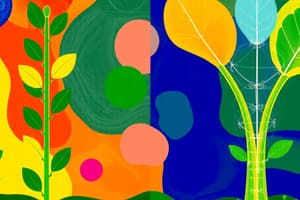Podcast
Questions and Answers
What are the two major groups of plant species based on their photosynthetic efficiency?
What are the two major groups of plant species based on their photosynthetic efficiency?
C3 plants and C4 plants
Which cycle do C3 plants use to fix carbon dioxide during photosynthesis?
Which cycle do C3 plants use to fix carbon dioxide during photosynthesis?
Calvin cycle
Give an example of a C4 plant species.
Give an example of a C4 plant species.
Corn, sugarcane, certain grasses
Why are C4 plants more efficient in terms of water conservation and carbon dioxide fixation?
Why are C4 plants more efficient in terms of water conservation and carbon dioxide fixation?
What is the main difference between C3 and C4 plants in terms of carbon dioxide fixation?
What is the main difference between C3 and C4 plants in terms of carbon dioxide fixation?
How does the respiration rate of C4 plants compare to C3 plants?
How does the respiration rate of C4 plants compare to C3 plants?
Explain the significance of the C4 cycle in plants.
Explain the significance of the C4 cycle in plants.
How does photorespiration differ in C4 and C3 plants?
How does photorespiration differ in C4 and C3 plants?
What are some potential applications of understanding the differences between C3 and C4 plants?
What are some potential applications of understanding the differences between C3 and C4 plants?
How can C4 plants help mitigate climate change?
How can C4 plants help mitigate climate change?
Flashcards are hidden until you start studying
Study Notes
Unleashing Photo Respiration: A Tale of C3 and C4 Plants
The Basics of Photosynthesis
Photosynthesis is the process through which plants create their own food by converting light energy into chemical energy, using water and carbon dioxide as inputs. This fundamental life cycle is the cornerstone of our planet's ecosystems, and understanding it in more detail reveals the fascinating world of plant adaptations.
Differentiating C3 and C4 Plants
The efficiency of this process can vary between different plant species, which can be broadly categorized into two major groups: C3 plants and C4 plants.
C3 plants are the most common and include species like rice, wheat, and soybeans. They fix carbon dioxide through a process called the Calvin cycle, which, while efficient in low light conditions, can lose some of its efficiency in high light environments as they release some carbon dioxide as a waste product during photosynthesis.
C4 plants, on the other hand, evolved to adapt to warmer and drier environments. They use an additional layer of photosynthesis, the C4 cycle, which is more efficient in terms of water conservation and carbon dioxide fixation. This cycle helps them minimize the loss of carbon dioxide during photosynthesis, a significant advantage in environments where water and carbon dioxide can be scarce. Species like corn, sugarcane, and certain grasses are examples of C4 plants.
Photo Respiration
The term "photo respiration" refers to the uptake of oxygen and release of carbon dioxide during photosynthesis, which is a necessary process for plants to maintain a level of energy production. This phenomenon is more pronounced in C4 plants, which have a higher respiration rate than C3 plants due to their more active photosynthetic process.
C4 plants have an additional set of cells called bundle sheath cells, which are responsible for fixing carbon dioxide using the C4 cycle. This process requires a high level of ATP, which is produced through the breakdown of glucose through cellular respiration in the mitochondria. The C4 cycle itself generates some oxygen as a byproduct, contributing to the higher respiration rate of C4 plants.
C3 plants, on the other hand, fix carbon dioxide directly in their mesophyll cells, which are not as efficient in fixing carbon dioxide as the bundle sheath cells in C4 plants. Because C3 plants do not have the same level of ATP demand as C4 plants, their respiration rate is comparatively lower.
Applications and Implications
Understanding the differences between C3 and C4 plants, along with photorespiration, can help us develop more efficient agricultural practices, such as breeding crops that have higher carbon dioxide fixation rates or finding ways to reduce water consumption in agriculture.
For example, the discovery of the C4 cycle has led to the development of crops like bioenergy sorghum, which can be used for producing biofuels. Such crops may be more efficient in terms of water usage and carbon dioxide fixation than traditional C3 crops.
Moreover, understanding the photorespiration process in C4 plants can aid in developing strategies to mitigate climate change. As C4 plants are more efficient in carbon dioxide fixation, they can potentially consume more carbon dioxide from the atmosphere, acting as a carbon sink that can help reduce the greenhouse effect.
In conclusion, C3 and C4 plants differ greatly in their photosynthetic processes, with C4 plants having a more efficient water and carbon dioxide fixation process. Understanding photorespiration in C4 plants, and its implications, can open new avenues for improving agricultural practices and addressing global challenges such as climate change.
Studying That Suits You
Use AI to generate personalized quizzes and flashcards to suit your learning preferences.



